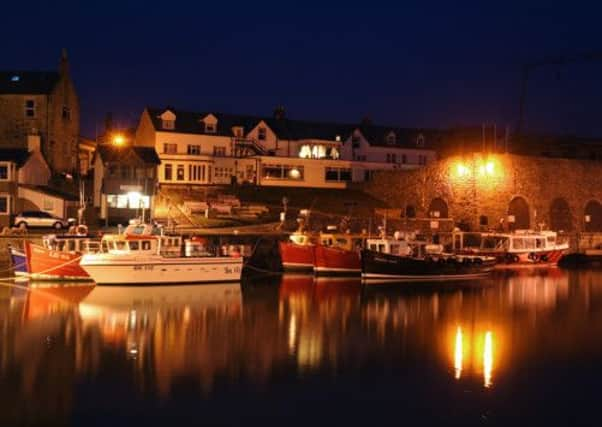The sands of time


I’m sitting in the Neptune Fish and Chip shop in Seahouses on the Northumbria Coast and I have to admit that I’m in some kind of vinegary heaven: I’ve just stuck my fork into a fat, fresh chip. I’ve dipped it in mushy peas and I’m raising it to my mouth. Does life get any better than this? I don’t think it does. Can an aesthete like me make a sandwich from chips and mushy peas? I think he can.
We’re up in the North East for a few days, staying in a cottage in Beadnell, a village just to the south of Seahouses that I always think of as Seahouses’s less brash cousin. Not that Seahouses is all that brash, but it’s got a slot machine place and a few fish and chip shops and some nice pubs and trip buses pull in and the service bus rolls through and there’s a sense of bustle that you don’t get in Beadnell. Of course Beadnell doesn’t have the Farne Gift Shop, one of the great seaside gift shops that should, in my humble opinion, be declared a UNESCO World Heritage Site. After all, where else could you buy chutney, wetsuits, toilet seat covers and model dinosaurs that you bury and then dig up? We bought a Seahouses thimble there for my mother-in-law that somehow got lost in transit, but that’s another story, to do with the mysterious and magical properties of that coast. In short, Beadnell has peace where Seahouses has novelty tea towels.
Advertisement
Hide AdAdvertisement
Hide AdOur cottage in Beadnell was called Duneside, and it does what it says on the tin, in that you look out of the window onto the dunes, the dunes that you scramble over to get to the beautiful beach. It was our third trip to the cottage, and in the past we’ve always done a similar kind of trip for our evening stroll: over the dunes, onto the beach, turn left, wander by the limekilns, gaze at the harbour, stroll back up to the road, back to the cottage and get the kettle on. I always felt the lack of a proper guidebook to Beadnell; I felt, as I often do when I’m wandering around aimlessly on my holidays, the need for more information about the place.
Well, I’m pleased to announce that on our latest jaunt we picked up a book called Limekilns and Lobsterpots by Katrina Porteous that told us everything we needed to know about Beadnell and sets it into context beside Seahouses and rest of that strip of coast.
The harbour is Beadnell’s jewel, a pocket-sized enclosure that, on the days we were there, protected the boats inside from the wild seas outside. Someone told me it’s the only westerly-facing harbour on the East Coast and the book backs that up; the harbour was built for the herring fishing, which was Beadnell’s main industry back in the 19th-century and meant that at certain times the whole of Beadnell Bay was extraordinarily busy. An 1828 account of a storm describes how “near one thousand poor fishermen in open boats” took shelter in the bay.
Today there are just three boats there, catching crabs and lobsters that are sold locally. On a cold and windy evening, you get an echo of what a welcoming sight the harbour lights would have been to fishermen trying to get home in a fierce force 10.
Advertisement
Hide AdAdvertisement
Hide AdWalk by the harbour and you come to this part of Beadnell’s other distinctive feature, the limekilns: there are three of them, dominating the harbourscape. It’s not too hard to imagine the scene: the limestone being put into the top of the kiln, then fired between layers of coal at temperatures of up to 1,000C, then taken in sloops to towns like Dunbar in Scotland. Now the kilns are cold, and they stand as memorials to the kind of economic boom and bust that has shaped much of our coastline.
From the harbour the book takes you to the South-West corner of the pier, so that you can look across to Dunstanburgh Castle; I like a book that just invites you to stare.
You then walk by the cottages built between the wars from the ruins of the herring yard and on to the promontory known as Ebb’s Neuk, a scheduled ancient monument because of the mysterious, brooding, buried presence of St. Ebba’s chapel.
Ebba was the daughter of the first king of Northumbria and her chapel dates from the 13th-century, more than five centuries after she died; Channel 4’s Time Team came to the site in 2011 hoping to find evidence of earlier burial sites and they did, burials at many different levels that just add to the sacred and mystical nature of the place.
Advertisement
Hide AdAdvertisement
Hide AdFrom Ebb’s Neuk the book takes you by the sea past the row of houses called the Windmillsteads, and towards Beadnell’s other distinctive feature, the fishermen’s huts or shiels. Again, if UNESCO have got a spare World Heritage Site or two they should give one to these unprepossessing wooden huts; until the 1990s there were eight of them on the site, now there are just a couple but they sing with history.
I’ll take Limekilns and Lobsterpots with me next time I go to Beadnell, because I’ll certainly be going back. Time for more fish and chips in Seahouses though, I reckon. And maybe a novelty teatowel or two. After all, I am an aesthete.
Getting there
Limekilns and Lobsterpots by Katrina Porteous is published by Windmillsteads Books, email [email protected]
Northumbria Coast and Country Cottages www.northumbriacottages.co.uk